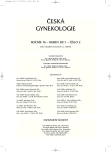Prevalence of women with overactive bladders in the Czech Republic
Authors:
A. Martan 1; L. Horčička 2; T. Hanuš 3; J. Krhut 4; L. Krofta 5; P. Kaucký 6; R. Zachoval 7
Authors‘ workplace:
Gynekologicko-porodnická klinika, 1. LF UK a VFN, Praha
1; GONA spol. s r. o., Praha
2; Urologická klinika, 1. LF UK a VFN, Praha
3; Urologické oddělení FN, Ostrava – Poruba
4; Ústav pro péči o matku a dítě, Praha
5; Pears Health Cyber s. r. o., Praha
6; Urologické oddělení, Fakultní Thomayerova nemocnice, Praha
7
Published in:
Ceska Gynekol 2011; 76(2): 144-150
Overview
Introduction:
The term OAB (overactive bladder) was introduced in praxis in the year 2002 by Abrams. This term includes symptoms of urgency, with or without urgent incontinence, and it is generally accompanied by urinary frequency and nocturia. OAB is widespread among our female population. Approximately 20% of women suffer from this problem, but the frequency of the syndrome has not been assessed more precisely by means of questionnaires. The aim of our study was to assess the prevalence of OAB among patients who visited gynecologists in the first line and completed the Bladder Control Self Assessment Questionnaire (BCSAQ).
Material and methods:
Five gynecologists in the first line questioned 492 consecutive patients as to whether they suffered from urgency, frequency, nocturia and urgent incontinence, and their answers were later evaluated. The BCSA questionnaires completed by the patients in the waiting room before seeing the doctor were subsequently also evaluated.
Results:
Due to inquiries made by the gynecologist, 320 patients took the BCSA questionnaires in the waiting room before seeing the doctor, and 314 completed them; 14 patients completed the questionnaires after seeing the doctor who questioned them about problems with urgency. The patients then handed the completed questionnaires to the nurse, i.e. the total of 328 questionnaires were assessed. 159 patients suffered from urgency, and 35% of these patients had problems with leakage of urine. In reply to the question: Is it difficult to hold urine when you have the urge to go? 22% of patients from the whole group of patients (n=492) answered yes. 24% of patients had problems with frequency, 32% with nocturia and 14% with urgent incontinence.
Conclusion:
OAB syndrome is widespread in our population; it constitutes a major problem which must be treated. Awareness of this problem has now improved; patients feel less embarrassed to discuss about problem, and increasingly they seek treatment, while at the same time gynecologists have improved their knowledge about the diagnosis and treatment of OAB. This means that the quality of life for these patients can be improved.
Key words:
overactive bladder, prevalence, Czech Republic.
Sources
1. Abrams, P., Cardovo, L., Fall, M., et al. The standardisation of terminology of lower urinary tract function: report from the Standardisation Sub-committee of the International Continence Society. Neurourol Urodyn, 2002, 21, p. 167-178.
2. McGrother, CW., Donaldson, MM., Shaw, C., et al. MRC Incontinence Study Team Storage symptoms of the bladder: prevalence, incidence and need for services in the UK. BJU Int, 2004, 93(6), p. 763.
3. Milsom, I., Abrams, P., Cardovo, L., et al. How widespread are the symptom sof an overactive bladder and how are they manager? A population-based prevalence study. BJU Int, 2001, 87, p. 760.
4. Irwin, DE., Milsom, I., Hunskaar, S., et al. Population-based survey of urinary incontinence, overactive bladder, and other lower urinary tract symptoms in five countries; results of EPIC study. Eur Urol, 2006, 50(6), p. 1306-1314.
5. Cardozo, L., Coyne, KS., Versi, E. Validation of the urgency perception scale. BJU Int, 2005, 95(4), p. 591-596.
Labels
Paediatric gynaecology Gynaecology and obstetrics Reproduction medicineArticle was published in
Czech Gynaecology

2011 Issue 2
Most read in this issue
- Extended embryo culture in IVF does not improve pregnancy rate
- Uterine fibroids and their treatment
- Luteal support in the IVF/ET programme
- Decreased fertility and today’s possibility of examination in reproductive immunology
